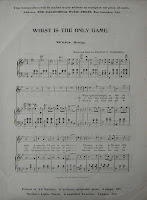An elaborate form of stage performance that has become popular of late years. It is also called "Spielkartenfest," or festival of playing cards. It is said that Mrs. George B. McLaughlin, of Philadelphia, noted its success abroad, and introduced it to the Quaker City in 1891...The amusement seems to have been suggested by living chess which was very popular as early as 1879.
In "living whist," as we have seen it played, the curtain rises, and a garden fête is seen in progress at the royal palace. One of the guests proposes that a game of whist be played, in which the officers and court ladies shall act the part of of hearts, clubs diamonds and spades, each being appropriately costumed...[W]hen the curtain rises again a tableau is presented of the entire complement of fifty-two cards. Then comes the game, and the cards are duly shuffled and dealt (by marching and countermarching)...(page 252)The most important book about a living whist performance is Musical Whist with Living Cards by Henry Jones ("Cavendish") (London: De La Rue and Dublin: William McGee, 1892). The book describes the centenary celebration of the Masonic Female Orphan School of Ireland, a week-long charitable event including stagings of living whist hands. Seven famous whist hands were acted out, including a hand from Thomson's Whist a Poem in Twelve Cantos (discussed here) and the play The Humours of Whist (discussed here and here). For each hand, Cavendish provides its history, describes the conduct of play (including the accompanying music and dance) and an analysis of the play.
Below are Cavendish's description of the conduct of a hand of living whist (left) and the hand from Thomson (right). Click to enlarge.
 |
| Musical Whist Levy [1256] |
 |
| Musical Whist Thomson hand |
Butler is certainly correct that living whist events were popular in the last decade of the 19th century. These were society events with lovely programs and much acknowledgement of the well-to-do participants. I have managed to collect several programs from living whist events (indeed these non-Hoyle essays are primarily a chance for my to show off unusual items in my collection), the earliest of which took place in San Francisco on November 12, 1892. The cover of the 56 page program is pictured below.
 |
| Living Whist (San Francisco) Levy [1598] |
The program explains the conduct of living whist much as does Cavendish:
The four players will take their respective positions as shown on the diagram [pictured below]. While the opening MARCH is being played, the cards appear in suits, and pass up and down the stage. At a certain signal, designated by the music, the SHUFFLE takes place, and at once the cards change from an orderly procession to an intricate confusion. The DEAL the follows, and the living characters, by a series of dextrous evolutions, are seen to arrange themselves towards the four parts of the state. The play...now opens. In playing a trick, the cards are led into the center and there execute a dance, varied according to the dignity of the Kings and Queens, the vivacity of Jacks or the cheerfulness of lesser cards. Every trick has its own figure, with music continually changing from minuet to waltz or quickstep. As the tracks are taken they range themselves near the winners. Each person bears upon his costume the respective card which he represents. This makes it easy for the audience to follow the tricks as they are played. (page 23)
 |
| Living Whist (San Francisco) The Players |
.JPG) |
| Living Whist Ayer Levy [1522] |
 |
| Living Whist Bethel Levy [1599] |
I will concede that these items seem rather silly to modern sensibilities, but they show the central role of whist in late 19th century society.






















